Scanning Electrochemical Microscopy-Somatic Cell Count as a Method for Diagnosis of Bovine Mastitis
Abstract
:Simple Summary
Abstract
1. Introduction
2. Materials and Methods
2.1. SECM-SCC with Inverted Cone-Shaped Well
2.2. Evaluation of Electrodes over Time: Validating Stability Using Cyclic Voltammetry Measurements
2.3. Cell Biochip to Obtain the Sensitivity Required for SECM-SCC
2.4. Understanding the Shape of the Oxygen Diffusion Layer
2.5. SECM-SCC with Milk Cell Chip
2.6. Evaluation of Respiratory Burst Using SECM-SCC
3. Results and Discussion
3.1. Correlation between Somatic Cell Count and Respiration Activity Using Inverted Cone-Shaped Well
3.2. Decrease in the Current Value over Time or Due to Collagen
3.3. Hemispherical Oxygen Diffusion Layer on Milk Cell Chip
3.4. SECM-SCC and Calibration Curve Using Milk Cell Chip
3.5. Immune Cell Evaluation under Respiratory Burst Using SECM-SCC
3.6. Bovine Examination by SECM–SCC
4. Conclusions
Supplementary Materials
Author Contributions
Funding
Institutional Review Board Statement
Informed Consent Statement
Data Availability Statement
Acknowledgments
Conflicts of Interest
References
- Bradley, A. Bovine Mastitis: An Evolving Disease. Vet. J. 2002, 164, 116–128. [Google Scholar] [CrossRef] [PubMed]
- Abebe, R.; Hatiya, H.; Abera, M.; Megersa, B.; Asmare, K. Bovine mastitis: Prevalence, risk factors and isolation of Staphylococcus aureus in dairy herds at Hawassa milk shed, South Ethiopia. BMC Vet. Res. 2016, 12, 270. [Google Scholar] [CrossRef] [PubMed] [Green Version]
- Zigo, F.; Vasil, M.; Ondrašovičová, S.; Výrostková, J.; Bujok, J.; Pecka-Kielb, E. Maintaining Optimal Mammary Gland Health and Prevention of Mastitis. Front. Vet. Sci. 2021, 8, 607311. [Google Scholar] [CrossRef] [PubMed]
- Sah, K.; Karki, P.; Shrestha, R.D.; Sigdel, A.; Adesogan, A.T.; Dahl, G.E. MILK Symposium review: Improving control of mastitis in dairy animals in Nepal. J. Dairy Sci. 2020, 103, 9740–9747. [Google Scholar] [CrossRef] [PubMed]
- Pyörälä, S. New Strategies to Prevent Mastitis. Reprod. Domest. Anim. 2002, 37, 211–216. [Google Scholar] [CrossRef] [PubMed]
- Cobirka, M.; Tancin, V.; Slama, P. Epidemiology and Classification of Mastitis. Animals 2020, 10, 2212. [Google Scholar] [CrossRef] [PubMed]
- Sharma, N.; Singh, N.K.; Bhadwal, M.S. Relationship of Somatic Cell Count and Mastitis: An Overview. Asian-Australas. J. Anim. Sci. 2011, 24, 429–438. [Google Scholar] [CrossRef]
- Hillerton, J.E. Redefining Mastitis Based on Somatic Cell Count, Bulletin of the International Dairy Federation No 345/1999: Quality and Safety of Raw Milk and Its Impact on Milk and Milk Products; International Dairy Federation: Brussels, Belgium, 1999; pp. 4–6. [Google Scholar]
- Viguier, C.; Arora, S.; Gilmartin, N.; Welbeck, K.; O’Kennedy, R. Mastitis detection: Current trends and future perspectives. Trends Biotechnol. 2009, 27, 486–493. [Google Scholar] [CrossRef]
- Dohoo, I.; Leslie, K. Evaluation of changes in somatic cell counts as indicators of new intramammary infections. Prev. Vet. Med. 1991, 10, 225–237. [Google Scholar] [CrossRef]
- Chaiyotwittayakun, A.; Aiumlamai, S.; Chanlun, A.; Srisupa, S. Alternative Method for Determination of Milk Somatic Cell Count in Dairy Cow. In Proceedings of the 15th Congress of the Federation of Asian Veterinary Associations, Fava-Oie Joint Symposium on Emerging Diseases, Bangkok, Thailand, 27–30 October 2008; pp. 17–18. [Google Scholar]
- Zajac, P.; Zubricka, S.; Capla, J.; Zelenakova, L. Fluorescence microscopy methods for the determination of somatic cell count in raw cow’s milk. Veterinární Med. 2016, 61, 612–622. [Google Scholar] [CrossRef] [Green Version]
- Kim, K.-S.; Noh, H.-W.; Lim, S.-D.; Choi, C.-H.; Kim, Y.-J. Development of Rapid Somatic Cell Counting Method by Using Dye Adding NIR Spectroscopy. Korean J. Food Sci. Anim. Resour. 2008, 28, 63–68. [Google Scholar] [CrossRef] [Green Version]
- Albenzio, M.; Caroprese, M. Differential leucocyte count for ewe milk with low and high somatic cell count. J. Dairy Res. 2010, 78, 43–48. [Google Scholar] [CrossRef]
- Zigo, F.; Elečko, J.; Farkašová, Z.; Zigová, M.; Vasiľ, M.; Ondrašovičová, S.; Lenka, K. Preventive methods in reduction of mastitis pathogens in dairy cows. J. Microbiol. Biotechnol. Food Sci. 2019, 9, 121–126. [Google Scholar] [CrossRef]
- Barnum, D.A.; Newbould, F.H. The Use of the California Mastitis Test for the Detection of Bovine Mastitis. Can. Vet. J. Rev. Vet. Can. 1961, 2, 83–90. [Google Scholar]
- Ruegg, P.L. A 100-Year Review: Mastitis detection, management, and prevention. J. Dairy Sci. 2017, 100, 10381–10397. [Google Scholar] [CrossRef] [PubMed] [Green Version]
- Norberg, E. Electrical conductivity of milk as a phenotypic and genetic indicator of bovine mastitis: A review. Livest. Prod. Sci. 2005, 96, 129–139. [Google Scholar] [CrossRef]
- Sheldrake, R.; McGregor, G.; Hoare, R. Somatic Cell Count, Electrical Conductivity, and Serum Albumin Concentration for Detecting Bovine Mastitis. J. Dairy Sci. 1983, 66, 548–555. [Google Scholar] [CrossRef]
- Akhtar, M.; Guo, S.; Guo, Y.-F.; Zahoor, A.; Shaukat, A.; Chen, Y.; Umar, T.; Deng, G.; Guo, M. Upregulated-gene expression of pro-inflammatory cytokines (TNF-alpha, IL-1 beta and IL-6) via TLRs following NF-kappa B and MAPKs in bovine mastitis. Acta Trop. 2020, 207, 105458. [Google Scholar] [CrossRef]
- Halasa, T.; Nielen, M.; De Roos, A.P.W.; Van Hoorne, R.; de Jong, G.; Lam, T.J.G.M.; van Werven, T.; Hogeveen, H. Production loss due to new subclinical mastitis in Dutch dairy cows estimated with a test-day model. J. Dairy Sci. 2009, 92, 1315. [Google Scholar] [CrossRef] [Green Version]
- Schukken, Y.H.; Wilson, D.J.; Welcome, F.; Garrison-Tikofsky, L.; Gonzalez, R.N. Monitoring udder health and milk quality using somatic cell counts. Vet. Res. 2003, 34, 579–596. [Google Scholar] [CrossRef] [Green Version]
- Oviedo-Boyso, J.; Valdez-Alarcón, J.J.; Cajero-Juárez, M.; Ochoa-Zarzosa, A.; López-Meza, J.E.; Bravo-Patiño, A.; Baizabal-Aguirre, V.M. Innate immune response of bovine mammary gland to pathogenic bacteria responsible for mastitis. J. Infect. 2007, 54, 399–409. [Google Scholar] [CrossRef] [PubMed]
- Alluwaimi, A.M.; Leutenegger, C.M.; Farver, T.B.; Rossitto, P.V.; Smith, W.L.; Cullor, J.S. The Cytokine Markers in Staphylococcus aureus Mastitis of Bovine Mammary Gland. J. Vet. Med. Ser. B 2003, 50, 105–111. [Google Scholar] [CrossRef] [PubMed]
- Mehrzad, J.; Duchateau, L.; Burvenich, C. Phagocytic and bactericidal activity of blood and milk-resident neutrophils against Staphylococcus aureus in primiparous and multiparous cows during early lactation. Vet. Microbiol. 2009, 134, 106–112. [Google Scholar] [CrossRef] [PubMed]
- Kimura, S.; Fukuda, J.; Tajima, A.; Suzuki, H. On-chip diagnosis of subclinical mastitis in cows by electrochemical measurement of neutrophil activity in milk. Lab Chip 2012, 12, 1309–1315. [Google Scholar] [CrossRef] [PubMed]
- Bard, A.J.; Fan, F.R.F.; Kwak, J.; Lev, O. Scanning electrochemical microscopy. Introduction and principles. Anal. Chem. 1989, 61, 132–138. [Google Scholar] [CrossRef]
- Bard, A.J.; Denuault, G.; Lee, C.; Mandler, D.; Wipf, D.O. Scanning electrochemical microscopy—A new technique for the characterization and modification of surfaces. Acc. Chem. Res. 1990, 23, 357–363. [Google Scholar] [CrossRef]
- Shiku, H.; Shiraishi, T.; Aoyagi, S.; Utsumi, Y.; Matsudaira, M.; Abe, H.; Hoshi, H.; Kasai, S.; Ohya, H.; Matsue, T. Respiration activity of single bovine embryos entrapped in a cone-shaped microwell monitored by scanning electrochemical microscopy. Anal. Chim. Acta 2004, 522, 51–58. [Google Scholar] [CrossRef]
- Shiku, H.; Torisawa, Y.-S.; Takagi, A.; Aoyagi, S.; Abe, H.; Hoshi, H.; Yasukawa, T.; Matsue, T. Metabolic and enzymatic activities of individual cells, spheroids and embryos as a function of the sample size. Sens. Actuators B Chem. 2005, 108, 597–602. [Google Scholar] [CrossRef]
- Kai, T.; Zoski, C.G.; Bard, A.J. Scanning electrochemical microscopy at the nanometer level. Chem. Commun. 2018, 54, 1934–1947. [Google Scholar] [CrossRef]
- Kaya, T.; Numai, D.; Nagamine, K.; Aoyagi, S.; Shiku, H.; Matsue, T. Respiration activity of Escherichia coli entrapped in a cone-shaped microwell and cylindrical micropore monitored by scanning electrochemical microscopy (SECM). Analyst 2004, 129, 529–534. [Google Scholar] [CrossRef]
- Kikuchi, H.; Prasad, A.; Matsuoka, R.; Aoyagi, S.; Matsue, T.; Kasai, S. Scanning Electrochemical Microscopy Imaging during Respiratory Burst in Human Cell. Front. Physiol. 2016, 7, 25. [Google Scholar] [CrossRef] [PubMed] [Green Version]
- Prasad, A.; Kikuchi, H.; Inoue, K.Y.; Suzuki, M.; Sugiura, Y.; Sugai, T.; Tomonori, A.; Tada, M.; Kobayashi, M.; Matsue, T.; et al. Simultaneous Real-Time Monitoring of Oxygen Consumption and Hydrogen Peroxide Production in Cells Using Our Newly Developed Chip-Type Biosensor Device. Front. Physiol. 2016, 7, 10. [Google Scholar] [CrossRef] [PubMed] [Green Version]
- Kasai, S.; Shiku, H.; Torisawa, Y.-S.; Noda, H.; Yoshitake, J.; Shiraishi, T.; Yasukawa, T.; Watanabe, T.; Matsue, T.; Yoshimura, T. Real-time monitoring of reactive oxygen species production during differentiation of human monocytic cell lines (THP-1). Anal. Chim. Acta 2005, 549, 14–19. [Google Scholar] [CrossRef]
- Torisawa, Y.-S.; Ohara, N.; Nagamine, K.; Kasai, S.; Yasukawa, T.; Shiku, H.; Matsue, T. Electrochemical Monitoring of Cellular Signal Transduction with a Secreted Alkaline Phosphatase Reporter System. Anal. Chem. 2006, 78, 7625–7631. [Google Scholar] [CrossRef] [PubMed]
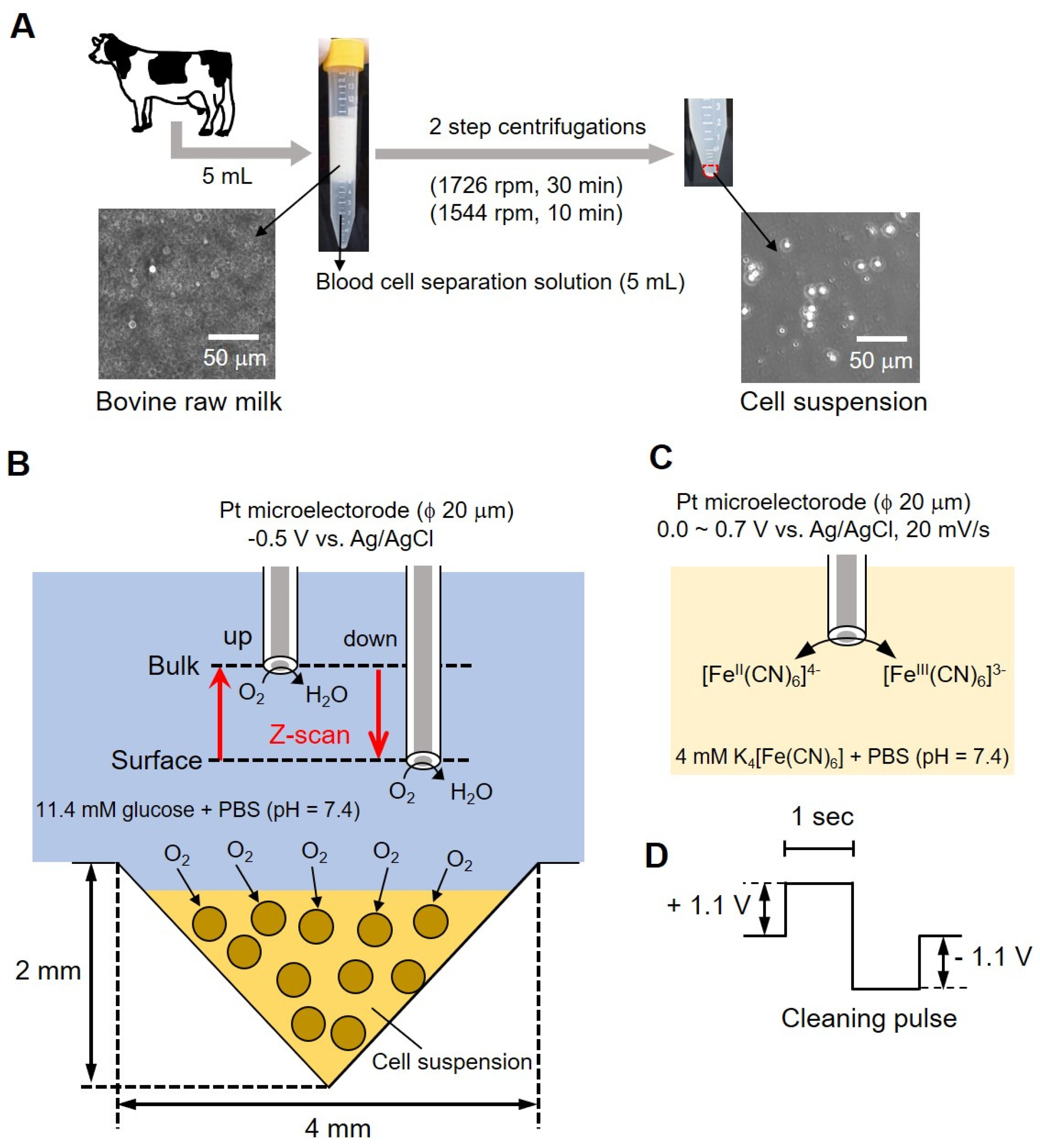

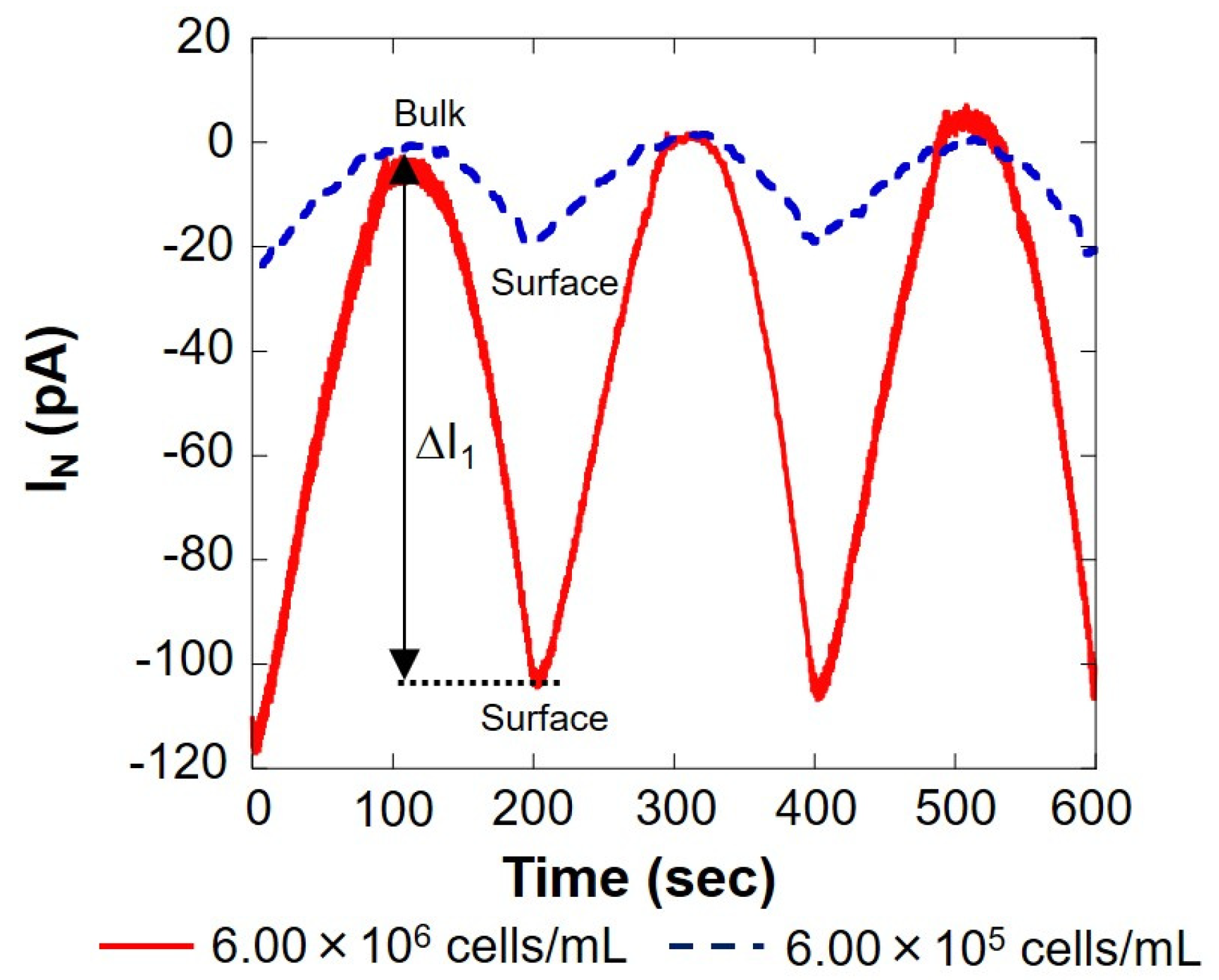
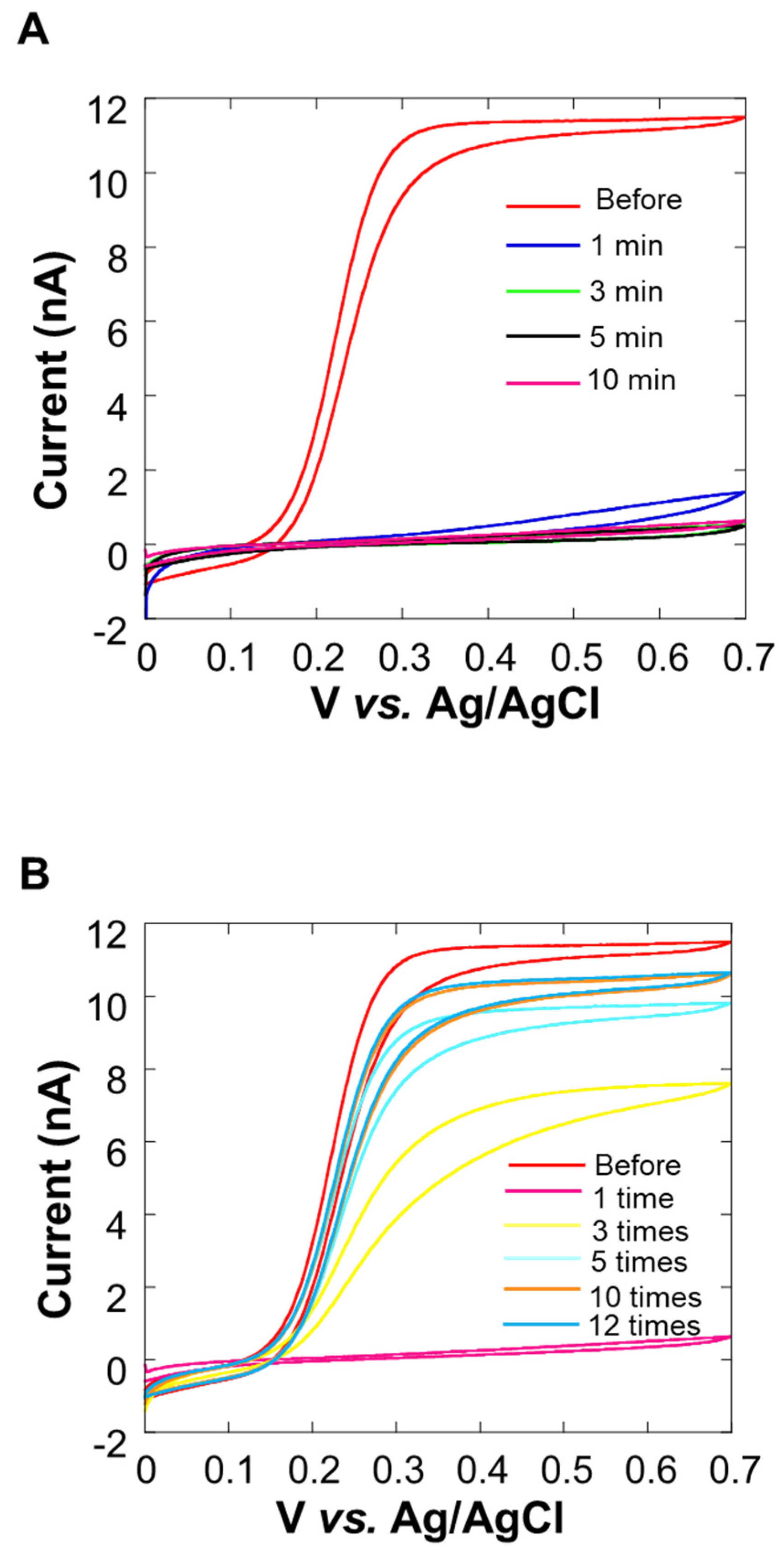
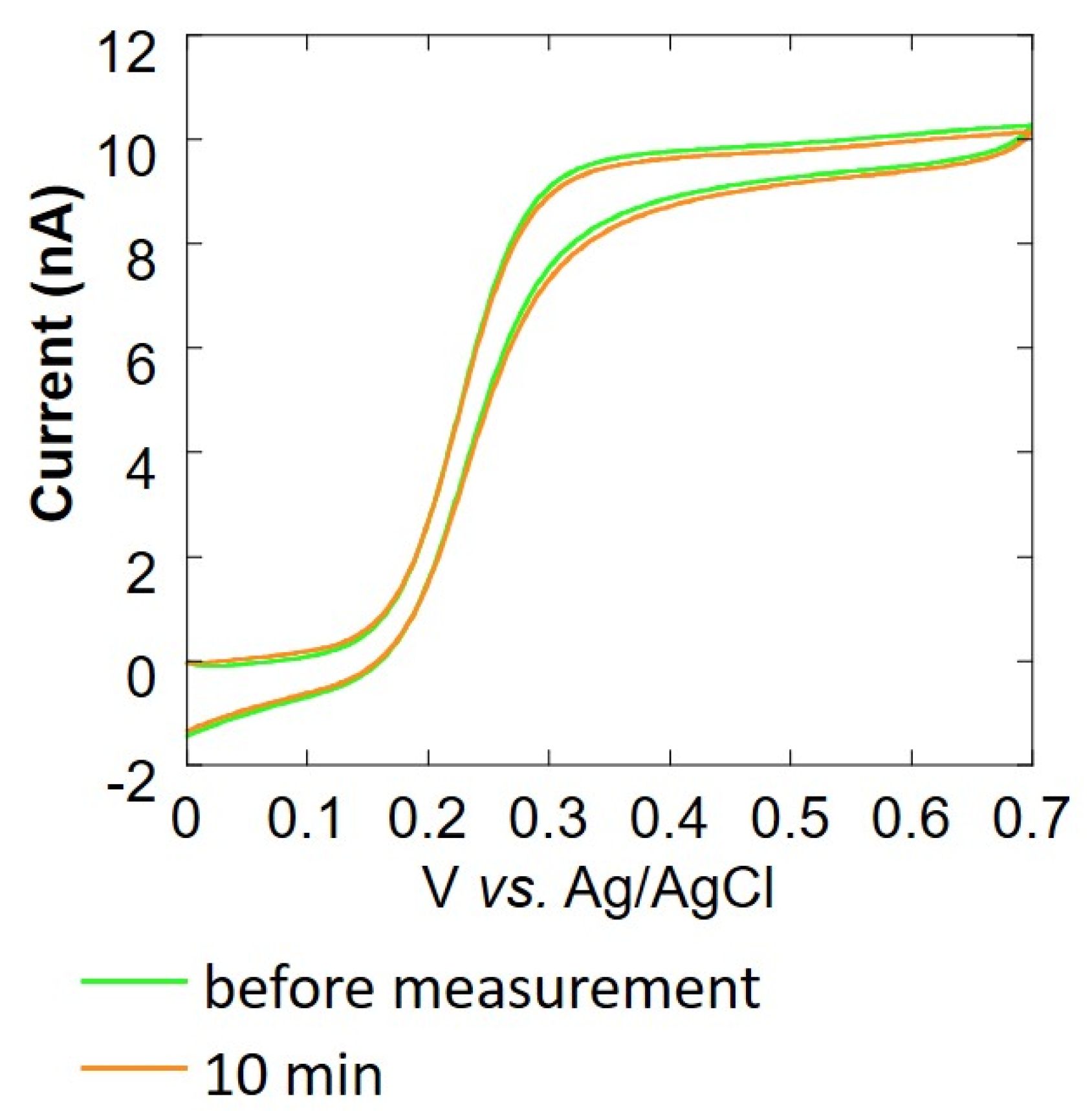
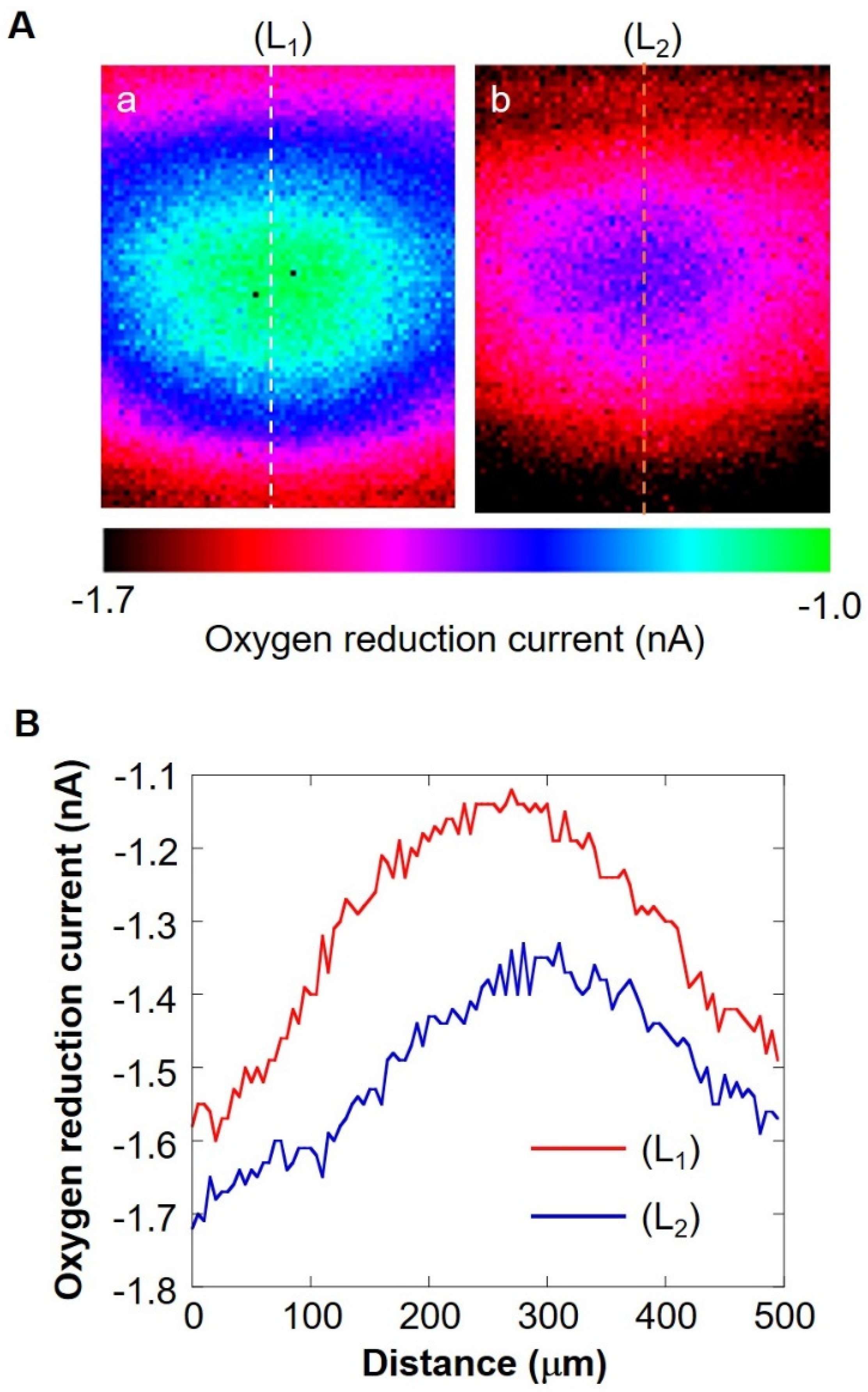
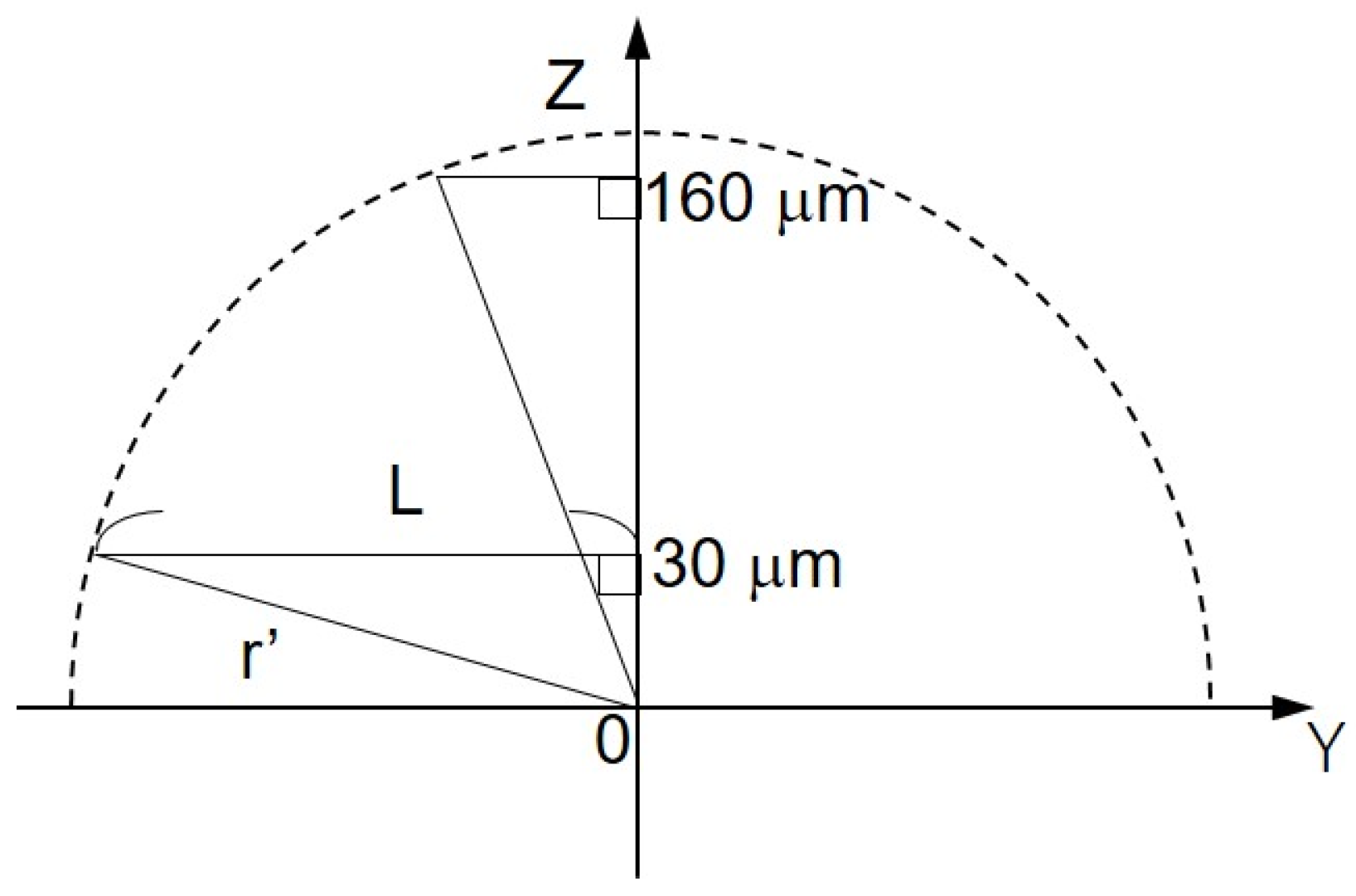

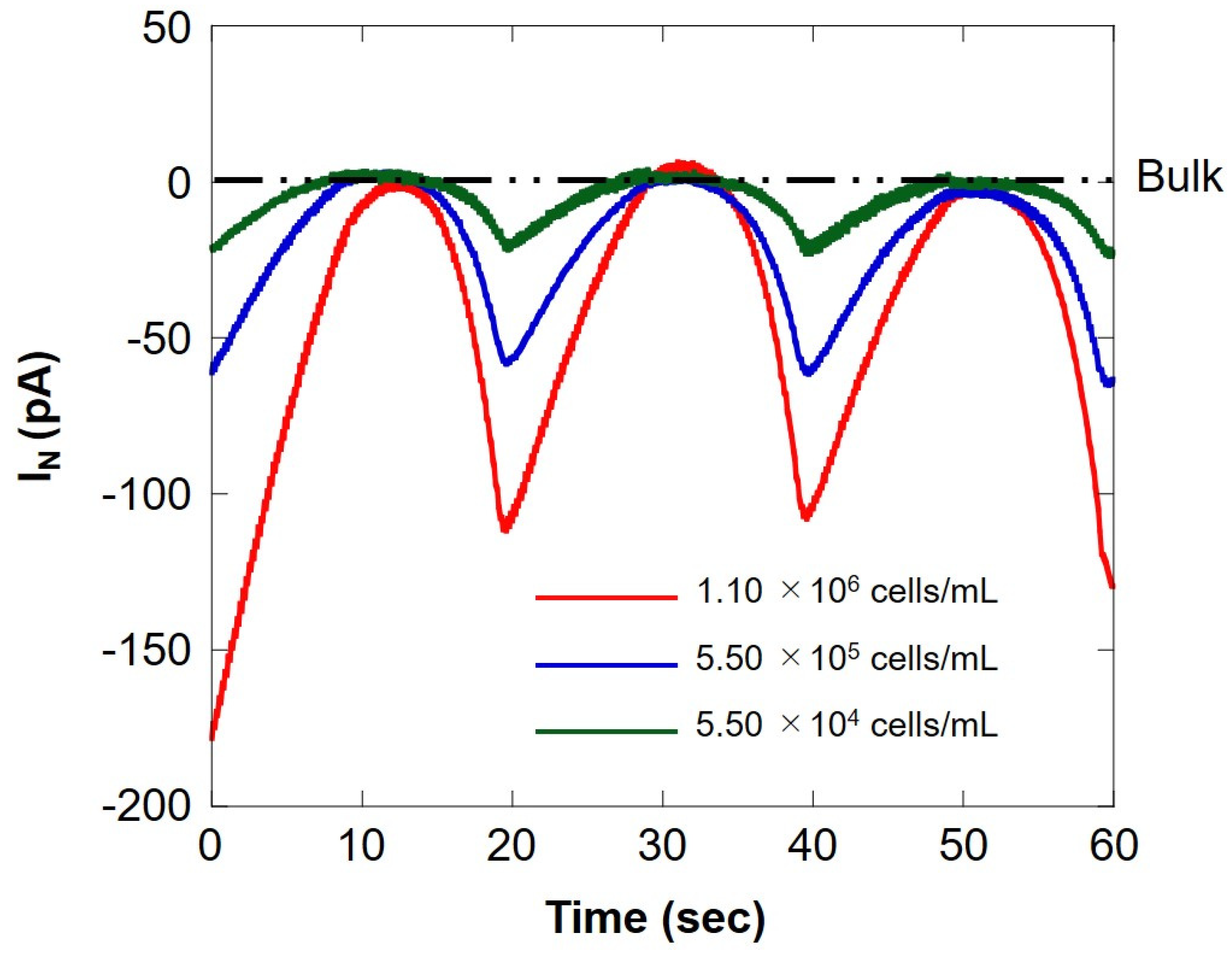
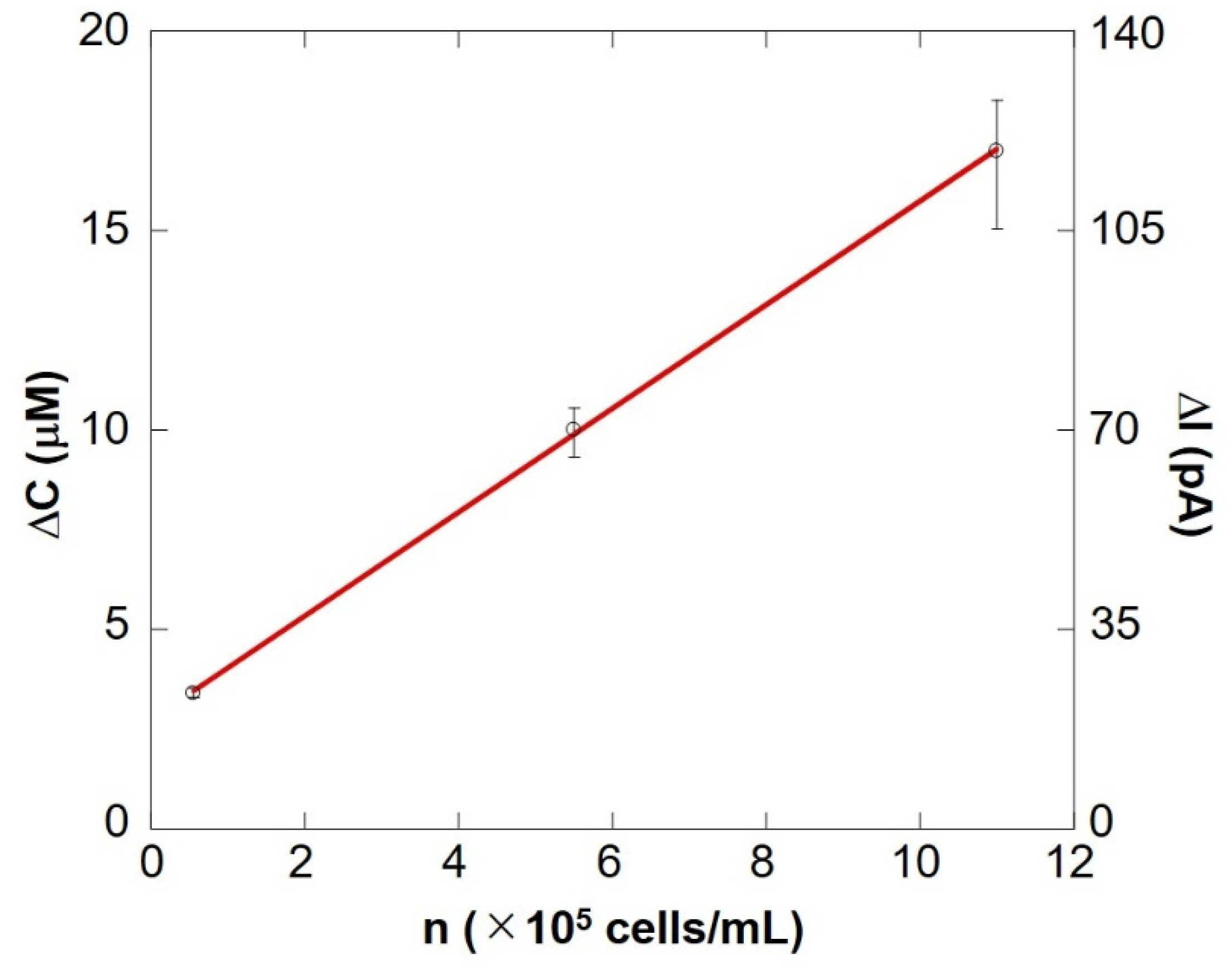
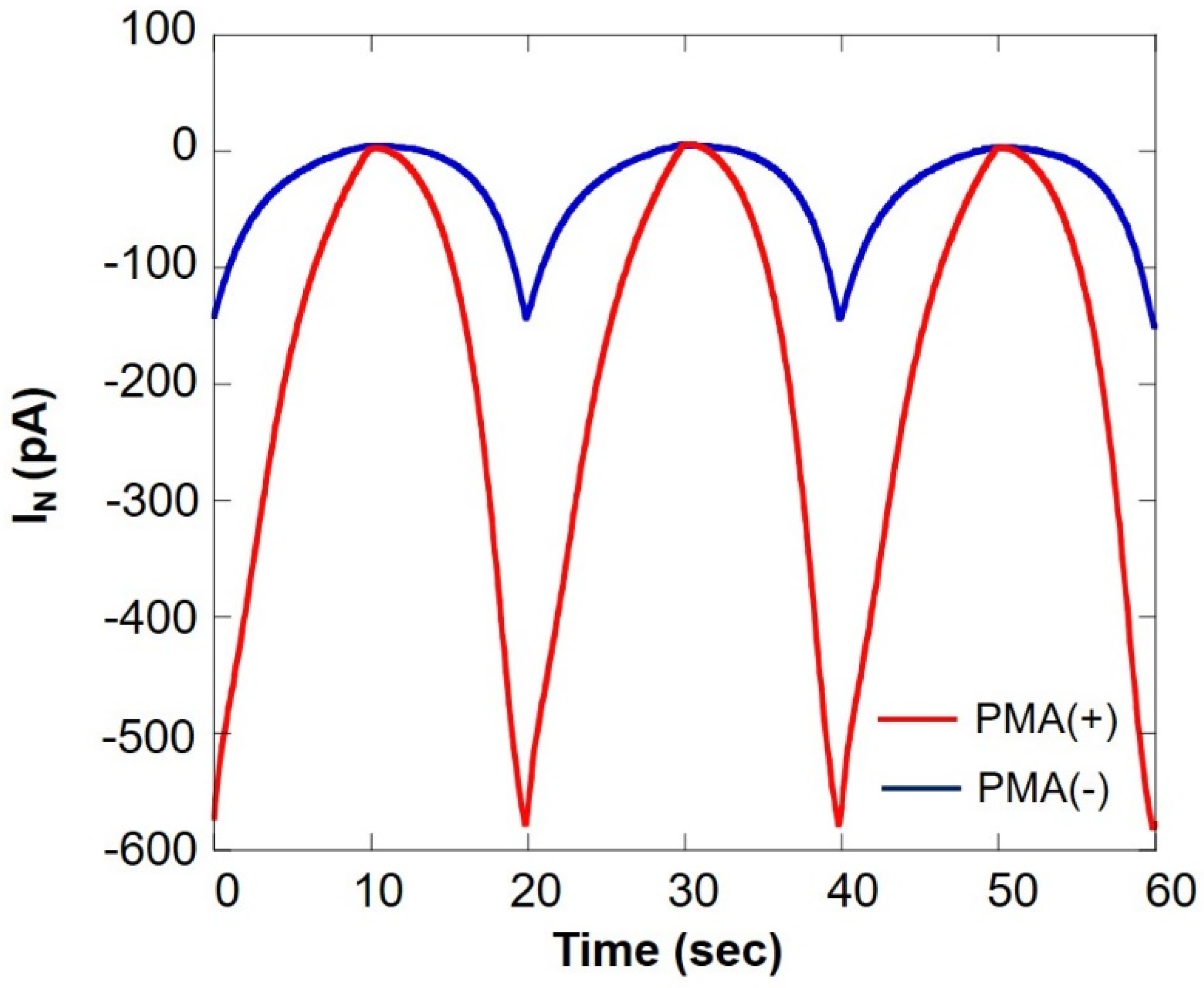

| Cell Number (cells/mL) | |ΔI| (pA) | ΔC (μM) |
|---|---|---|
| 6.00 × 106 | 105 | 15 |
| 6.00 × 105 | 20 | 2.9 |
| Number of Cells (cells/mL) | |ΔI| (pA) | ΔC (μM) | F × 1014 (mol/s/well) |
|---|---|---|---|
| 1.10 × 106 | 116 | 17 | 2.3 |
| 5.50 × 105 | 70 | 10 | 1.4 |
| 5.50 × 104 | 23 | 3.4 | 0.44 |
| |ΔI| (pA) | Number of Somatic Cells Estimated Using SECM-SCC (cells/mL) | |
|---|---|---|
| Bovine sample 1 | 115 | 1.08 × 106 |
| Bovine sample 2 | 74 | 6.20 × 105 |
Publisher’s Note: MDPI stays neutral with regard to jurisdictional claims in published maps and institutional affiliations. |
© 2022 by the authors. Licensee MDPI, Basel, Switzerland. This article is an open access article distributed under the terms and conditions of the Creative Commons Attribution (CC BY) license (https://creativecommons.org/licenses/by/4.0/).
Share and Cite
Kasai, S.; Prasad, A.; Kumagai, R.; Takanohashi, K. Scanning Electrochemical Microscopy-Somatic Cell Count as a Method for Diagnosis of Bovine Mastitis. Biology 2022, 11, 549. https://doi.org/10.3390/biology11040549
Kasai S, Prasad A, Kumagai R, Takanohashi K. Scanning Electrochemical Microscopy-Somatic Cell Count as a Method for Diagnosis of Bovine Mastitis. Biology. 2022; 11(4):549. https://doi.org/10.3390/biology11040549
Chicago/Turabian StyleKasai, Shigenobu, Ankush Prasad, Ryoma Kumagai, and Keita Takanohashi. 2022. "Scanning Electrochemical Microscopy-Somatic Cell Count as a Method for Diagnosis of Bovine Mastitis" Biology 11, no. 4: 549. https://doi.org/10.3390/biology11040549
APA StyleKasai, S., Prasad, A., Kumagai, R., & Takanohashi, K. (2022). Scanning Electrochemical Microscopy-Somatic Cell Count as a Method for Diagnosis of Bovine Mastitis. Biology, 11(4), 549. https://doi.org/10.3390/biology11040549






